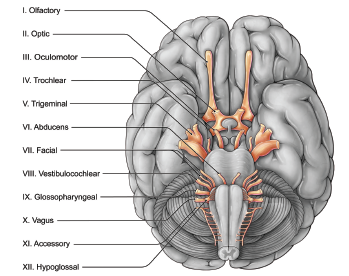Therapeutic Effect

Figure 1. Proximity of the cranial nerve nuclei that may account for cross stimulation.
© Evan Oto / Science Source
The proximity of cranial nerve nuclei in the brainstem is only recently being exploited for clinical benefit,” said Sujana Chandrasekhar, MD, a partner with ENT & Allergy Associates, LLP, associate clinical professor of otolaryngology at Icahn School of Medicine at Mount Sinai in New York City, and an associate editor of ENTtoday (see Figure 1).
Explore This Issue
November 2019Saying that the study advances understanding of the cross-responsiveness between the vagus nerve nucleus and the cochlear nucleus, Dr. Chandrasekhar emphasized the need for more research. “The cross-responsiveness seen in VNS may hold promise in the treatment of auditory pathology, including certain subtypes of tinnitus,” she said. However, although the procedure is generally safe, she cautioned that it is not without risk and that future research is necessary before it can potentially be clinically useful.
Bruce Gantz, MD, professor and head of the department of otolaryngology–head and neck surgery at the University of Iowa in Iowa City, expressed strong caution about the use of this technology for auditory problems. Although he said that the pilot study (Sci Rep. 2017;7:11960) reported some support for a larger clinical trial on the use of this technology for tinnitus, he noted that results of a multicenter trial (not yet published) did not yield a clinically significant benefit in reducing tinnitus. “Whether or not stimulation of the vagus nerve would enhance auditory perception in humans needs further evaluation,” he said, “but I am not very enthusiastic at this point following our experience with tinnitus.”
However, J. Thomas Roland, Jr, MD, chair of the department of otolaryngology–head and neck surgery and professor of otolaryngology and neurosurgery at NYU Langone Medical Center in New York City, thinks this is an exciting area of research.
He and his colleagues are working on a rat model in which they are stimulating the locus aurelius deep in the brain via the vagus nerve to examine the effect on auditory tasks. Rats are first deafened and then trained on tasks linked to different tones (J Neurophysiol. 2016;116:844–858; Brain Res. 2018;S0006-8993(18)30324-X). “We found that if we stimulate the locus aurelius, [the rats] learn the auditory tasks three times as fast, and it only takes a few days [of learning] instead of two weeks,” he said. “I don’t know if that is improving their hearing or just improving their brain’s response to hearing.”
Down the road, Dr. Roland said, they’re interested in testing this technology in people with cochlear implants. “We’re looking at this as a future technique to enhance outcomes with a cochlear implant,” he said. That said, his research is focused on using VNS to enhance hearing with a prosthesis such as a cochlear implant, unlike the current study.
As to that research, “I think this is very preliminary and is another step and more evidence that this may be a very viable way to assist people with hearing,” Dr. Roland said. “I’m happy that other researchers are looking at [VNS] from different angles. It has tremendous potential in a relatively noninvasive way to enhance hearing and auditory learning.”